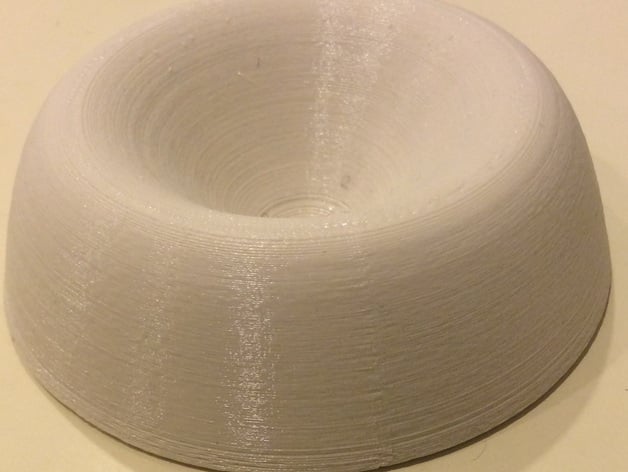
Finding Volume: Shell Method
thingiverse
This activity is designed to help Calculus students visualize how to calculate volume by the shells method. Students will be given a typical volume problem and create 5 to 7 cylinder shells to approximate the shape, then make the actual shape and calculate the volume. Print Settings Printer Brand: MakerBot Printer: MakerBot Replicator Rafts: Yes Supports: No Resolution: standard Infill: 10% How I Designed This To create the rotated object and cylinder shells, I first got the 2-dimensional graph using desmos.com. Then I did a printscreen to capture the graph [figure 1]. I used an online SVG converter and opened it in 123d Design. I used the polyline tool to enclose the region [figure 2]. Then I used polyline again to draw a line acting as the y axis that this shape would get rotated over [Figure 3]. Next, I drew rectangles at each interval point with a small width [Figure 4]. Then I used the revolve tool to rotate each rectangle around the line I drew [Figures 5 and 6]. To get the full object, I revolved the whole graph around the line [Figure 7]. I also printed the object with a slice taken out so students can see the cross section. This was done by inserting a wedge and then subtracting it from the object [Figure 8]. Figures 1. 2. 3. 4. 5. 6. 7. 8. Standards NGSS: CCSS: Overview and Background Project: Finding Volume: Shell Method Students understand how the shell method for finding volume works and create a model of both the approximation with shells and the actual 3D figure. Students will learn how to find the volume of a region using the shells method and why the formula works. Lesson Plan and Activity The full details are in the attached worksheet. Here is a brief overview. First assign each student (or group) a region that they will be rotating around the y-axis. Then have them use desmos.com, or a similar graph plotter, to plot their region. Then they will split the x values into 6-8 subintervals and create corresponding cylinder shells with radius x and height f(x). Next, they will think about the full region rotated and print that. Then they will get the formula for surface area of a cylinder and volume of the rotated region. Finally, they will calculate the volume for their region. Skills Learned Volume of a Region: Cylinder Shells Duration of Lesson The activity itself can be completed in one day, but printing the rotated object will take a couple hours. Preparation This activity should be done at the point in Calculus when students first learn how to find volume by shells. They probably have already done volume by discs and have all of the pre-requisite knowledge, such as knowing how to evaluate integrals. You might need to remind them of the equation for circumference of a circle. Rubric and Assessment Here is a sample rubric to use with the worksheet. Question (points) 1 (2) 2 (2) 3 (10) 4 (20) 5 (5) 6 (11) Total 50 References It could be helpful to give a quick review of Riemann sums or have students watch a video on the topic. https://www.khanacademy.org/math/integral-calculus/indefinite-definite-integrals/riemann-sums/v/simple-riemann-approximation-using-rectangles
With this file you will be able to print Finding Volume: Shell Method with your 3D printer. Click on the button and save the file on your computer to work, edit or customize your design. You can also find more 3D designs for printers on Finding Volume: Shell Method.
